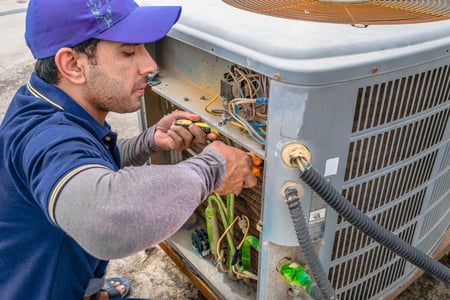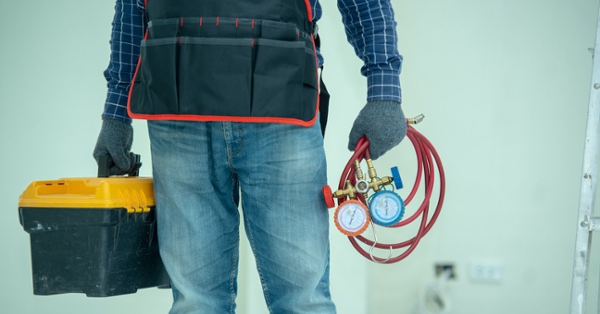4 Components That Put Your HVAC Company at Risk for Compliance Violations
6 MIN. READ
 If you work with subcontractors, it is your responsibility to ensure that they meet all your compliance requirements before you hire them. Losing track of these four contractor management components can put your company at risk of compliance penalties.
If you work with subcontractors, it is your responsibility to ensure that they meet all your compliance requirements before you hire them. Losing track of these four contractor management components can put your company at risk of compliance penalties.
Fortunately, Raiven (formerly Qmerit) has the software tools to guide you through potential legal, financial and delay minefields by tracking critical subcontractor information in real time.
Digitizing subcontractor management processes is the crucial foundation
It is important to recognize that trying to manage subcontractor compliance without enabling technologies is a futile effort. Developing and tracking it on multiple Excel spreadsheets, or worse, paper records, is labor-intensive and inefficient, especially for small companies with limited resources. You need one readily accessible, easily updated contractor management solution.
Discover some compliance risks below and then explore how Raiven can mitigate them by digitizing your contractor management processes.
1. Contractor licensing
In general, almost every state has requirements for contractor licensing. Make sure you understand the requirements in your state, city and county.
Your subcontractor contracts should specifically require the license appropriate for the trade involved. Licensing requirements help ensure a basic knowledge of the trade and a clean business record.
If the authorities find that your subcontractor is unlicensed, both you and they may be subject to fines, the removal of the contractor from the job and the refusal to pay by the customer. You will also lose valuable time in the process by dealing with citations and even litigation.
It makes no sense to hire unlicensed subcontractors.
Another point to keep in mind is that while the subcontractor may be licensed at the time of hiring, what about three years down the road? Do you have mechanisms in place to ensure you receive a notification when their license is about to expire and receive a copy when they renew? You need to ensure that you are promptly notified of license expirations and timely renewals to stay compliant.
2. Insurance
As a contractor, the law may hold you liable for injuries, physical damage, or other casualties or claims on the site, even if a subcontractor caused them. This is especially true if you exercise close control over their activities.
Thus, it is crucial for you to ensure that subcontractors carry adequate insurance, including the coverages below with appropriate limits. Failure to do so may put you at risk of lawsuits to pay for damages or claims.
-
Property and casualty - Covers physical damage due to listed causes like fire, flood and theft.
-
Commercial general liability/umbrella liability - Pays to defend against claims and lawsuits against the subcontractor.
-
Automobile liability - Covers claims due to the operation of cars and trucks on site.
-
Workers' compensation/employer liability - Covers claims by subcontractor employees due to an on-the-job injury or another employment-related claim. Each state usually determines limits.
Be sure to seek advice from your insurance agent on coverage and limits to carry. Where possible, make sure that you are named additional insured on subcontractor policies so that their insurance, not yours, responds to a claim. This preserves your limits of coverage for your own use and protects your insurance rates.
Note that you cannot be named as additional insured on workers' compensation policies as you do not employ the subcontractor's workers.
Make sure that these coverages are in place before the start of the project and that your contract requires that you are notified of their expiration dates and renewals. If a policy lapses and a loss occurs, you may be stuck with the cost and hassle of dealing with the claim.
3. I-9 forms
The Immigration Reform and Control Act requires employers to prove the identity and employment eligibility of their employees using an I-9 form for anyone hired to work for wages in the United States.
The I-9 form must be in place before the employee starts work, and employers must keep a copy of each employee's I-9. Additionally, U.S. Immigration and Customs Services can inspect workplaces to determine whether all I-9 forms are in order.
Missing or inaccurate forms can lead to penalties ranging from $583 to $23,331 per incident for knowing violations, along with lost time and hassle. Criminal penalties for serious violations are also possible.
This is not a requirement to be lax about. Make sure that your subcontractor is contractually bound to have these forms in place and available.
4. Safety training
The U.S government's Occupational Safety and Health Administration regulates workplace safety. As a contractor on site, you are responsible for maintaining a safe workplace.
This means that you must develop and publish a safety plan for the site. Similarly, your subcontractors are responsible for safety in their operations and must also have a plan in place. The safety plans for both contractors and subcontractors must conform to OSHA minimum requirements.
You can be held responsible for failure to comply on your own. If the subcontractor fails to do so, you may be held liable for their failure as well. Make sure that your contracts require that your subcontractors comply with your own safety policies to avoid any conflicts.
OSHA violations can be costly. Penalties for serious offenses can range from $13,653 per occurrence to $136,532 for willful or repeated ones. Your insurance rates can also go up as a result of violations and accidents.
A good way to mitigate safety issues is to require that your subcontractor's employees receive safety training. If possible, they should be tested and you should receive evidence that they passed the test.
So, now that I know the contractor management risks, what can I do to avoid them?
Raiven has the answers!
Raiven's contractor management platform provides a self-service portal that enables your subcontractors to upload all their licenses, insurance and other credentials - and keep them up to date. Both your employees and subcontractors are notified when their credentials near expiration, and if they do expire, they cannot receive job requests until they update their documentation.
All their information becomes centralized so you can quickly find the best-performing contractors whose credentials are up to date, initiate electronic bids, and have complete visibility into their performance, including responsiveness, quality and compliance. So, it is easy to track valid licensing, insurance, I-9 forms and OSHA compliance. Subcontractors simply upload their compliance information, and you monitor it in real time - no more manual tracking on Excel, less time wasted and more effective risk management!
While you are at it, to save money on supplies, consider Raiven Marketplace. If you do not want to commit resources to an in-house procurement team, sign up for our industry-first buying consortium with Avendra. You can save 7-25% on supply purchases by using our universe of precontracted, prequalified suppliers, and you have the ability to extend these discounts to your subcontractors!
Contractor compliance risks can cost you time, money and your reputation. Raiven has the tools to help you mitigate those risks as well as get you better pricing with contractors.
For more information, contact us today.



